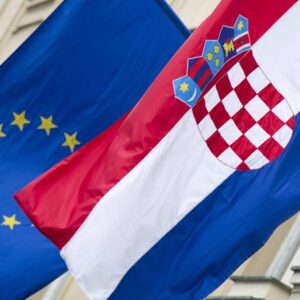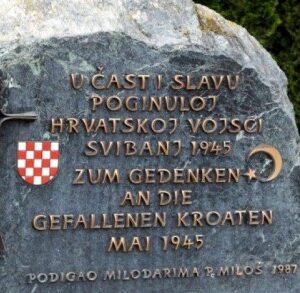Author: Ina Vukić
At Bleiburg field in Austria in May 1945 and for months afterwards along the killing fields known as The Way of the Cross, Yugoslav communists eliminated those they saw as their real opponents, those who rejected communism and Yugoslavia: the bourgeois, businessmen, clergymen, elderly, women, children, soldiers fighting for independent state of Croatia or those defending its borders and all those who might oppose the new communist regime.
The Bleiburg Massacre refers thus to a series of killings carried out by Josip Broz Tito’s communists and partisans which occurred in May 1945, immediately following the end of World War II in the European hub where the murdered and massacred Croats, having fled the newly-declared communist Yugoslavia, sought refuge and asylum under British protection. They sought protection from the communist partisans. The British, however, sent them back south in a forced march that delivered them to be massacred at the hands of Tito’s partisans. The majority of the victims were Croats and Slovenes, with communities of ethnic Germans and Italians also being greatly affected. Communist revolutionaries used foibes, deep sinkholes found in karst, to dispose of the bodies of perceived enemies—many of whom were still alive when dropped into the geologic cavities often referred to as pits; other forms of mass graves were also used, such as burials. Victims included both military personnel of the WWII Independent State of Croatia and civilians.
The fate of the these Croatian refugees, both soldiers and civilians, was decided at the February 1945 Yalta Conference. Joseph Stalin demanded the surrender of all Soviet citizens who had fought with the Germans, and the same yardstick was applied to ‘Yugoslav’ citizens. At first, when the first soldiers and civilians arrived in Bleiburg, Austria, the British welcomed them and promised that they would be taken to Italy, but trains took them back to Yugoslav territory starting May 12, 1945, and brutal death by extermination awaited at the other end. In other cases, the British refused to accept the surrender of the new arrivals and allowed the partisans to take them prisoner. This went on for several days. Later, the British would excuse themselves by saying that Tito had promised humane treatment for the prisoners. The British have indeed much to answer for the blood on their hands here!
During the first fortnight of May 1945, as the war drew to a close in Yugoslavia, terrified Croatian people streamed across hundreds of kilometres of mountains and rivers, on foot, in a desperate attempt to surrender to the British who administered that part of post-war Austria. What they sought above all was protection from the Communist Partisans. Terrifying massacres were being perpetrated behind the Yugoslav lines, and there were few who did not anticipate a ghastly fate in the event of capture, regardless of their actions during the chaotic years of occupation and war.
Hoaning into today’s official Croatia May 8th is being celebrated as liberation of Zagreb Day! Former communists and/or their children or grandchildren who still hold the candle for the former communist Yugoslavia and are still very active and powerful, call the Day of Liberation of Zagreb, the capital of Croatia, May 8, 1945, while the absolute truth is that on that day in 1945 Josip Broz Tito’s communist partisan hordes marched into militarily undefended Zagreb, intent on mass murder of patriotic Croats. The Serbian Chetnik-partisan units entered the city first, while the Croatian ones were left at a safe distance. What followed was the massacre of the people of Zagreb, which is still celebrated today as the “liberation of Zagreb”. However, no one was ever held accountable for this heinous crime. Many people still build their careers on that crime, live in mansions, villas, and enormous apartments stolen from patriotic Croats and Jews, and call it “anti-fascism”. The mass crimes committed by the revolutionary communism of the Yugoslavia that include well over one thousand mass graves of butchered and murdered innocent Croatian patriots within months of World War Two end, the demon of communism survived Croatia’s exit from communist Yugoslavia independence war of 1990’s to now rules the roost as it were. What a human tragedy!
While in May 1945 killings were being carried out along and across Zagreb’s meadows and forests, Tito’s closest associate, dissatisfied with the scale and speed of the killings, wrote to the Yugoslav communists in Zagreb in his own hand: “Your work with Zagreb is unsatisfactory. In 10 days, only 200 bandits were shot in liberated Zagreb. We are surprised by this indecision to clean Zagreb of those criminals. You are doing the opposite of our orders, because we told you to work quickly and energetically and to finish everything in the first days. You are forgetting that…” (Aleksandar Ranković, Serbian communist considered to be the most powerful mani n communist Yugoslavia after Josip Broz Tito).
About 130 mass graves of victims of communist crimes have so far been unearthed in Zagreb and its immediate surroundings and over one thousand across Croatian territory. If everything were discovered and investigated, and if Jasenovac and Macelj sites were investigated in international scientific cooperation, matters of the character of these “liberators”, their purpose and meaning, would be placed in their right historical and moral place. Such a thing requires a political decision. However, nothing happens in this direction from mandate to mandate of government, which perpetuates the myth of Jasenovac Camp, which favours Greater Serbian politics, and which directly harms the Croatian state and people. No one questions the poisoned basis of the key social division, nor offers solutions. Communist crimes are not a topic in Croatia. Where this topic pops up from time to time is labelled by both the members of the government and opposition as well as communism-leaning followers as a reactionary revisionism of the enemies of the people at work. And so “more than thirty years of independence in Croatia have passed in the atmosphere of ‘demons in democracy’, the concept found in Ryszard Lagutko’s book ‘The Demon in Democracy – Totalitarian temptations in free societies,’ (2016), says Croatian journalist and publicist Nenad Piskac last week.
Consequently, even in free and independent Croatia, the political elites behave as an extended arm of the communist Yugoslavia’s OZNA (Department for Protection of the People), i.e. as its polished prosthesis for the 21st century. OZNA was a revolutionary repressive organisation, founded in 1944 with Aleksandar Ranković at its head, which had precisely defined tasks. As a “single powerful organisation”, it was supposed to manage “political intelligence abroad and in the occupied territory and counterintelligence service in the NOVJ (People’s Liberation Army of Yugoslavia) and in the occupied territory and in the non-occupied territory” (Founding Document of OZNA). As long as the Croatian state exists, its territory is “occupied” according to the criteria of OZNA (and its successors). Where there is no Croatian state, there is “free territory”. The logic could not get more totalitarian but, sadly to most, it works. And so, OZNA was to guard and protect the inheritance passed on by the “People’s Liberation War” (World War Two) and this involved the preparation in 1944 for purges sfter the WAr’s end, for the mass murders of hundreds of thousands of Independent State of Croatia soldiers and fighters (Ustashe and Home Guards equally) and hundreds of thousands of civilians, women, children, elderly who had been on Croatian independence side during the war.
In these and such circumstances, the reckoning of the totalitarian regime with Archbishop Alojzije Stepinec was prepared, for which the OZNA also had a pre-developed written script, or step-by-stem scenario for the demise of Blessed Alojzije Stepinac, at the time Archbishop of Zagreb, based on false allegations and lies. In these and such circumstances of communist murderous rampages hundreds of thousands of patriotic Croats were purged in the State-ordered murders post World War Two from that small country called Croatia, which then continued as part of communist Yugoslavia!
Lest We Forget!
Ina Vukic




